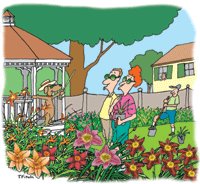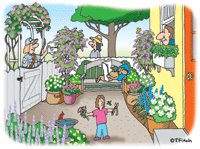 Daylilies have emerged as one of the most popular perennials in American gardens. Unfortunately, while the genus Hemerocallis has grown in favor, many gardeners and landscape designers seem to have directed their attention to only one lustrous variety, ‘Stella de Oro,’ while overlooking the staggering range of color, height, bloom size, and form found among the hundreds, if not thousands, of varieties readily available.
Daylilies have emerged as one of the most popular perennials in American gardens. Unfortunately, while the genus Hemerocallis has grown in favor, many gardeners and landscape designers seem to have directed their attention to only one lustrous variety, ‘Stella de Oro,’ while overlooking the staggering range of color, height, bloom size, and form found among the hundreds, if not thousands, of varieties readily available.Daylilies have been aptly cited as the perfect perennial, as there are cultivars which can fit almost any garden situation, from steep hillsides and hot, sunny borders, to somewhat shady areas prone to flooding. Moreover, daylilies properly situated will thrive and spread, becoming more massive and impressive with each successive year. Do not let the delicate petals of ‘Ruffled Apricot’ or creamy-peach ‘Martha Adams’ deceive you; these plants are tough and can handle seasonal drought or week-long deluges with an aplomb usually only found in native plants.
Thanks to the efforts of thousands of professional and amateur hybridizers, there are now upwards of 40,000 named varieties of daylily, each with unique qualities and characteristics. And while most are not commercially available, there is assuredly a dizzying catalog of choices to be had simply through local nurseries, specialty garden centers, and mail-order companies.
The key to selecting daylilies for your garden is to consider how you plan to use them, create a rough design, and then develop a daylily planting plan. Of course, if you are simply hoping to spruce up the area around a lamppost, you can probably get by with purchasing about four or five of the same variety, even ‘Stella de Oro,’ if you insist, to create an impressive massed planting. Similarly, if you simply want to intersperse colorful daylilies among clumps of ornamental grasses, or add brilliance to an otherwise dull evergreen foundation planting, you should consider using a single outside row of small to medium-sized plants which will not overshadow the other plants.
For a more spectacular display, using daylilies either alone or combined with other perennials, you will need to do some planning before purchasing or planting. Keep in mind that daylilies come not only in different sizes and colors, but also have varied blooming seasons, usually two to four weeks long. To ensure that your daylily border or garden will have successive blooms all season long, usually from late spring through late summer, you will have to note each desired plant’s blooming time.
Actually, the simplest approach is to consult a good reference work on daylilies, most of which provide photographs and planting tables. You will find that bloom seasons are usually divided into six periods, from “early-early” to “very late.” Your planting plan should accommodate the full range of blooming times, spreading each period throughout the full extent of the garden bed.
In addition, your planting matrix should account for the respective height of the plants. Height is based on the “scape,” the leafless stem supporting the buds and blossoms, and typically ranges from low (6” – 2’), to medium (2-3’), up to tall (more than 3’). Consider height along with bloom period. You don’t want the foliage of a ‘Paul Bunyon’ hiding an ‘Eenie Weenie,’ not that you would necessarily want to buy something named Eenie Weenie.
Finally, your planting plan should include your desired color palette, blending your assortment with existing perennials, or complementing the colors of other daylilies. You should note that the beauty of a daylily blossom owes as much to the color of the flower’s throat as to the petals themselves, and to the blending and shades of color and patterns found in each flower. Also, daylily devotees look for interesting shapes or forms in flowers, whether spider-like, flaring, the traditional trumpet shape, triangular, or even the exotic-looking “doubles,” often reminiscent of peonies.
If buying a daylily suddenly sounds complicated – relax. There are a number of intermediate steps between sticking a single plant in a whiskey barrel planter and designing an award-winning demonstration garden. You can start off by purchasing several different plants that strike your fancy. Perhaps you are really taken by the wide elegant ruffles of ‘Saffron Glow’, or the rich, light aroma of old time ‘Hyperion.’ Why not bring them home? To avoid the calculus of bloom periods, select plants known to bloom over a long period or time – or to rebloom readily.
Many gardeners find that a couple of daylilies soon turn into a collection as the years go by. Just adding one or two per year can lead to horticultural drama, especially with the help of propagation. In fact, beyond their beauty and other merits, daylilies have attained enormous popularity as one of the easiest perennials to divide.
Depending on the particular variety, you may find that your single plant has become a large clump after about four years – a clump much in need of division. There are several methods of division worth mentioning.
If you would like to keep your original clump in place and simply “harvest” some of the extra growth, you have the option to remove some of the outer fans which have spread from the center. A “fan” is a complete plant, containing roots, crown and several leaves. Use a sharp shovel to carefully pull or chisel away at least several fans per division. Removing a single fan will produce a skimpy new plant which may require years to bloom. It is better to harvest several good-sized divisions than a dozen small ones.
You can also slice through the center of the clump with your shovel while the plant is in the ground, divide the clump in half. You may also want to divide each half once again. Remove the sections and replant them, including at least one section in the original spot.
A more effective and preferred method requires removing the entire clump and using a hose to rinse any soil from the roots. Cleaning the plant makes it easier to identify each of the fans and helps to strategically separate them. Most growers prefer using a sharp knife to carefully separate each division, with four to five fans per division.
By propagating and replanting your daylilies, you can soon expand a modest plot begun with ten plants into a dazzling display of 50 or more specimens in a handful of years, especially if you add one or two new plants each year. And, once bitten, why not consider joining a local chapter of the American Hemerocallis Society, where fellow enthusiasts can provide guidance, along with free plant swapping sessions to keep your collection growing.
Select Bibliography:
Hemerocallis: The Daylily, R. W. Munson, Jr., Timber Press, 1989
Daylilies: The Perfect Perennial, Lewis and Nancy Hill, Storey Books, 1991.
The Color Encyclopedia of Daylilies by Ted L. Petit, John P. Peat, Timber Press, 2000.
Copyright 2009, Joseph M. Keyser








